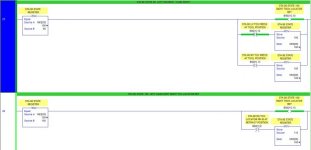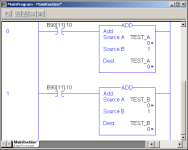Hoping someone can shed some light on this... I didn't write this program, but I inherited it and constantly find myself shaking my head while trying to streamline it.
I noticed this today while combing through looking for an indexing problem. How is this output even energizing? With an indexer only allowing one of the rungs to be true at a time, wouldn't there always be a de-energized version of the output holding it in the "off" state?

I noticed this today while combing through looking for an indexing problem. How is this output even energizing? With an indexer only allowing one of the rungs to be true at a time, wouldn't there always be a de-energized version of the output holding it in the "off" state?





